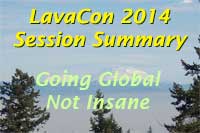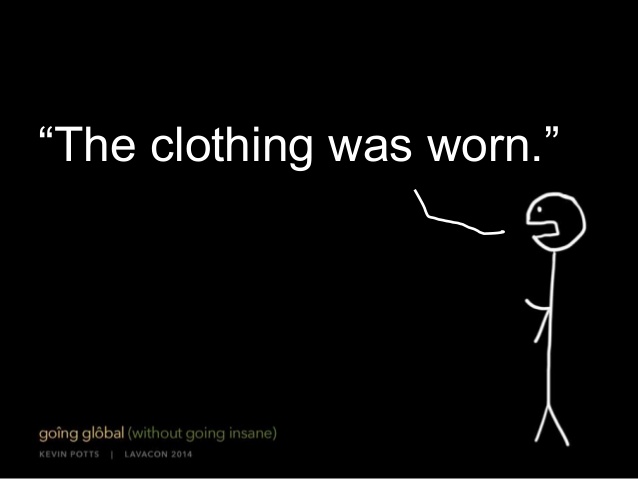Going Global Without Going Insane
 Presenter: Kevin Potts, Lexmark (Twitter: @KevinPotts)
Presenter: Kevin Potts, Lexmark (Twitter: @KevinPotts)
Slideshare: http://www.slideshare.net/kevinpotts/going-global-40178875
I like it when presenters set their stage with the plan to share firsthand knowledge and the upfront statement that this stuff is hard. Kevin Potts dove right into his presentation by sharing, with over 7100 languages in the world, each with so many dialects and cultural nuances, there are infinite ways to communicate poorly.
A sharp dose of wit, impactful slides, and numerous helpful examples made this presentation click along. Slide 4 set the stage: “Language is hard. Meaning is harder.” This statement goes along with the industry knowledge that localization goes beyond translation of text, but pertains to matching cultural expectations of the audience to create exceptional customer experiences.
Kevin broke his intended takeaways from the presentation into three challenges, and provided guidance on how to approach each challenge.
Challenge 1: Expect complications.
If you know there are challenges ahead and accept them upfront, you are more likely to succeed in your localization efforts in terms of audience reception and ROI for your organization.
Challenge 2: Your language is not my language.
Said so well, I had to capture an important takeaway in a tweet.
Globalization is complicated. Some countries have multiple languages & some languages span multiple countries. @kevinpotts #lavacon2014
— Jill Parman (@ForWordConsult) October 14, 2014
Where you do business determines which languages you will choose (rather than just assuming Mandarin Chinese is the language to choose because it’s the most widely spoken language in the world).
Challenge 3: Translation versus meaning.
To kick off the discussion about this challenge, Kevin put a poorly constructed sentence on the screen: “The clothing was worn.” If the sentence is constructed so poorly in English, the source language, how could someone expect the translated sentence to be any better? The discussion moved into topics all communicators are familiar with, including the need to write tighter and in plain English. Kevin went a step further after reminding us to avoid clichés and stop ‘verbing’ nouns by talking about the often forgotten sibling, imagery within the content. Images need to be localized rather than translated to respect cultural influences. The best approach is to seek opinions from the target market and ruthlessly edit just like you would with words. I’ve read articles about translating and localizing content, but I’ve often left wondering, “Now what? How do I apply this information?” Kevin’s examples helped the learning to stick immediately such as the claim that you’re not effectively localizing content for a Chinese audience by using a photo with a fortune cookie placed in front of a group of staged Chinese people. Chinese people don’t eat fortune cookies, so it provides no localized value.
Another great example, captured on Twitter by another LavaCon presenter, Terena Bell, focused on banking in Germany. They don’t write checks.
They don’t write checks in Germany-have been digital 20 yrs. Don’t have pics of people writing checks on yr localized site #fintech #LAVACON
— Terena Bell (@InEveryLanguage) October 14, 2014
Kevin then moved into some takeaways and gotchas based on his experience at Lexmark. He recommended creating a common engagement path for all stakeholders with a clear answer to the question, “Who do I talk to?” Find your experts to serve as “traffic cops” throughout the engagement, be transparent with the budget, and identify in-country reviewers. Extend the expected timeframe by 1.5x, not because the translation always takes a long time, but because errors will be found in the review and publication cycles. Work to find people to work with whose best interests lie in successful efforts, such as sales and marketing staff who need the customer-facing content to be impactful.
He also discussed the pros and cons of the four types of translators: He explained that a blend of each is often the best solution for a localization project and that most vendors will collaborate well when they’re not the sole localization partner.
Kevin shared how technology can help the process of localization with structured content, automated workflows, and stress testing of translated content. He wrapped up his presentation by sharing some of the processes and lessons learned at Lexmark. “Bend, don’t break” is the way Lexmark handles localization efforts.
